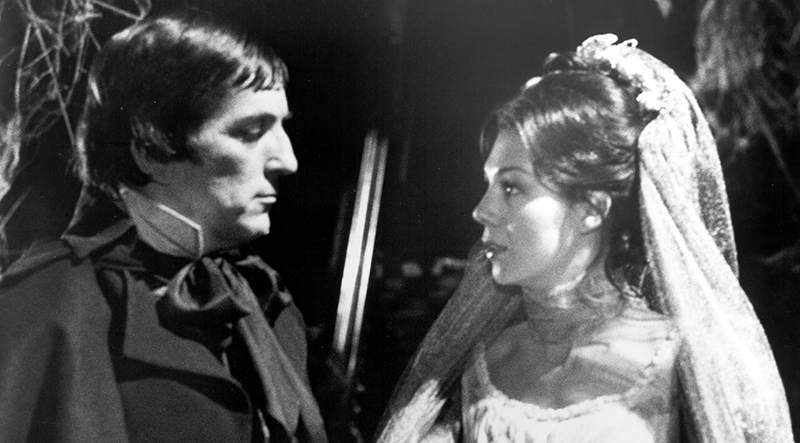When Barnabas Collins (Jonathan Frid) first stepped out of his coffin on Dark Shadows in 1967, viewers were introduced to a different kind of vampire. More than a predator, Barnabas was a tragic figure, forever haunted by the memory of Josette Du Pres, the 18th-century woman he once loved and inadvertently doomed. His longing for her transcended death and time, and when he encountered Victoria Winters (Alexandra Moltke) and, especially, Maggie Evans (Kathryn Leigh Scott)—modern women who bore an uncanny resemblance to Josette—his obsession flared anew. Thus, one of the most enduring tropes in vampire fiction was cemented: the idea that a vampire believes a modern woman is the reincarnation of his lost love, and is determined to reclaim her.
Origins and Early Influences

Though Dark Shadows gave this motif its most iconic television expression, the concept predates the show and can be traced to Gothic and Romantic literature. One of the earliest and most notable examples is Edgar Allan Poe’s “Ligeia” (1838), in which the narrator becomes convinced that his deceased wife Ligeia returns in the body of his second wife. While not a vampire story, it sets the emotional and supernatural groundwork for the motif of lost love and spiritual return.
In the stage world, Le Vampire (1820), a play by Charles Nodier, featured a vampire seducing women who reminded him of someone from his past, though it stopped short of overt reincarnation. Later, Sheridan Le Fanu’s Carmilla (1872) hinted at similar themes of romantic fixation across generations.
But the clearest influence likely came from the romantic horror films of Universal and Hammer Studios. In The Mummy (1932), Boris Karloff’s undead Imhotep believes the modern heroine is the reincarnation of his ancient Egyptian lover, a plot device that would echo directly in Dark Shadows. Universal’s Dracula’s Daughter (1936) also explored a vampire’s lingering grief and attraction to mortal women in ways that blend sorrow and obsession.
Dark Shadows and the Blueprint

In Dark Shadows, Barnabas Collins was introduced as a villain—but quickly became a fan-favorite anti-hero, largely because of the aching sadness at his core. He didn’t thirst for power or domination so much as he longed for lost love. Josette’s death was his great trauma. With Maggie Evans, writers were able to explore the tragedy of love unfulfilled. But it also introduced a darker subtext: the dangers of romantic idealization and the terror of a love that refuses to let go.
Dark Shadows redefined the vampire mythos for a new generation, giving emotional weight to what had largely been monsters. The “reincarnated love” trope became a cornerstone of the show’s emotional and supernatural drama, influencing decades of vampire fiction to follow.
Legacy in Later Vampire Media
Bram Stoker’s Dracula (1992)

Francis Ford Coppola’s lush, operatic adaptation of Dracula adds a layer not found in the novel: the idea that Mina Harker is the reincarnation of Dracula’s ancient wife, Elisabeta. This transforms Dracula from predator to tragic romantic, echoing Barnabas’s yearning and moral ambiguity.
Forever Knight (1992–1996)

Detective Nick Knight is a vampire in search of redemption, often haunted by past lovers. Though not always explicitly about reincarnation, the ghosts of his romantic past loom over his relationships with mortal women, much like Barnabas and Josette.
The Vampire Diaries / The Originals

The CW’s vampire dramas leaned heavily on this trope, particularly in the character of Elena Gilbert, who is the doppelganger of the ancient Katherine Pierce. The Salvatore brothers’ divided love for them echoes Barnabas’ entanglement with Josette’s various lookalikes.
Let the Right One In (2008)
Though subtler, this haunting Swedish film (and its adaptations) explores the emotional dependency between vampire and human, suggesting a longing that stretches across time and trauma—another echo of Barnabas’ endless grief.
Only Lovers Left Alive (2013)
Jim Jarmusch’s artful meditation on eternal love features two vampires, Adam and Eve, whose centuries-spanning relationship is a more balanced, philosophical variation on the theme.
Why the Trope Endures

This motif endures because it speaks to the most potent of human fantasies and fears: the idea that love can transcend death, and the equally terrifying possibility that it might not let go. In vampire fiction, where immortality blurs the lines between devotion and obsession, the idea of a reincarnated lover gives emotional heft to horror.
Barnabas and Josette remain the archetype. She is never allowed to rest, and he is never allowed to heal. Their tragedy isn’t just romantic—it’s existential. And every vampire who follows in his footsteps, searching for a lost love in the face of a modern stranger, carries a little of their story with them.
